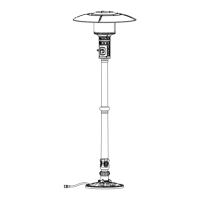Manual,Instructions & Parts List
PATIO HEATER
FOR YOUR SAFETY
If you smell gas:
1. Shut off gas to the appliance.
2. Extinguish any open flame.
3. If odor continues ,immediately
call gas supplier.
FOR YOUR SAFETY
Do not store or use gasoline or
other flammable vapors or liquids
in the vicinity of this or any other
appliance.
WARNING: For Outdoor Use Only.
CAUTION: Retain the instructions
for future use.
Natural Gas
CERTIFIED
I
S
G
E
N
D
C
D
E
E
R
I
T
F
I
Model No.:SRPHN02
Master Contract No.:217109
Customer Item No.: PTHC38NK

